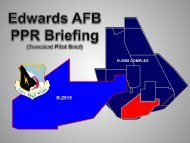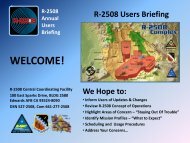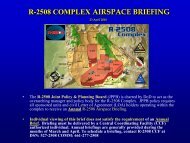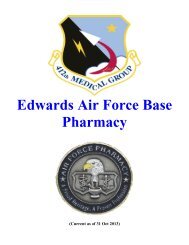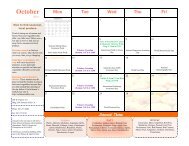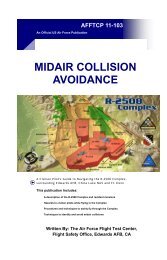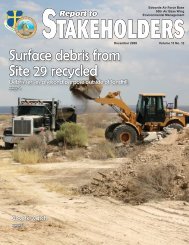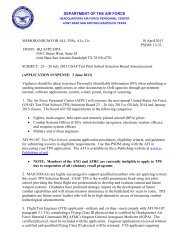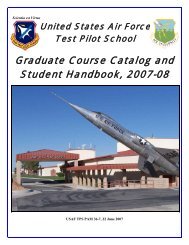AF Plant 42 AICUZ Study - Feb. 2012 - Edwards Air Force Base
AF Plant 42 AICUZ Study - Feb. 2012 - Edwards Air Force Base
AF Plant 42 AICUZ Study - Feb. 2012 - Edwards Air Force Base
Create successful ePaper yourself
Turn your PDF publications into a flip-book with our unique Google optimized e-Paper software.
2.6.2 Flight Tracks over the Ground<br />
For aircraft stationed at <strong>Plant</strong> <strong>42</strong> temporarily while undergoing depot<br />
maintenance or initial manufacturing and acceptance, the typical<br />
sortie consists of: a departure from <strong>Plant</strong> <strong>42</strong> on the runway heading; a<br />
turn toward the test and training airspace over <strong>Edwards</strong> <strong>AF</strong>B; air<br />
work in the Restricted Area or MOAs over <strong>Edwards</strong> <strong>AF</strong>B; and, an<br />
arrival back at <strong>Plant</strong> <strong>42</strong>. For aircraft stationed at and arriving from<br />
Channel Islands ANGB or <strong>Edwards</strong> <strong>AF</strong>B (i.e., proficiency flights),<br />
the typical sortie consists of: a departure from either Channel Islands<br />
ANGB or <strong>Edwards</strong> <strong>AF</strong>B; an initial arrival into <strong>Plant</strong> <strong>42</strong>; a varying<br />
number of closed circuit patterns with low approaches or touch and<br />
go landings; and, a final departure to return to the base at which the<br />
aircraft is stationed.<br />
The flight patterns (also referred to as flight tracks) are designed<br />
taking several factors into account and the operations most commonly<br />
observed along these tracks are a function of several factors<br />
including:<br />
<br />
<br />
<br />
<br />
<br />
The prevailing weather conditions, particularly the winds<br />
which influences the runway in use at an airfield at any given<br />
time;<br />
The mission or purpose for which the sortie is being flown,<br />
and, closely related, the locations of the most commonly used<br />
training airspace units;<br />
Terrain;<br />
Separation requirements from other aircraft in the vicinity<br />
including those in the mid- and upper altitude strata (greater<br />
than 10,000 feet above MSL); and<br />
Noise abatement considerations.<br />
Of these factors, the prevailing winds (which influences whether<br />
operations occur on Runways 4/22, or 7/25) and the mission (i.e.,<br />
what training or operational scenario is being flown to and from<br />
which areas) are the predominant factors that influence which of the<br />
many flight tracks possible are the ones most commonly observed.<br />
Generally, operations occur from east to west on Runway 25 due to<br />
the prevailing winds, noise abatement, and other considerations such<br />
as air traffic in the area. It is the preferred calm wind runway.<br />
Military fighter aircraft use an<br />
overhead arrival pattern in<br />
which the aircraft flies over<br />
the arrival end of the runway<br />
at pattern altitude (normally<br />
1,500 feet above ground level<br />
(AGL), then banks sharply to<br />
the left or right, turning to a<br />
heading opposite that of the<br />
runway in use. This sharp<br />
turn is also called a “pitch” or<br />
a “break.” Using the turn to<br />
slow down while holding<br />
pattern altitude, the aircraft is<br />
then flown parallel to the<br />
runway (downwind),<br />
configures its flaps and<br />
landing gear, and when<br />
beyond the threshold of the<br />
runway begins a descending<br />
turn toward final approach<br />
such that the plane rolls out<br />
wings-level at the proper<br />
airspeed on about a 1 mile<br />
final and about 300 feet AGL.<br />
This technique minimizes<br />
vulnerability to enemy fire<br />
and provides additional<br />
altitude in the event of aircraft<br />
malfunctions.<br />
Civil aircraft ordinarily<br />
approach the runway,<br />
descending on a more gradual<br />
glidepath and seldom overflying<br />
the threshold at pattern<br />
altitude. The tight turns at high<br />
rates of speed that are required<br />
in order to stay within the<br />
vicinity of the airfield generate<br />
G forces beyond the design<br />
capabilities of most civil<br />
aircraft and would also result in<br />
an unpleasant ride for<br />
passengers not expecting such a<br />
vigorous maneuver.<br />
2-14



